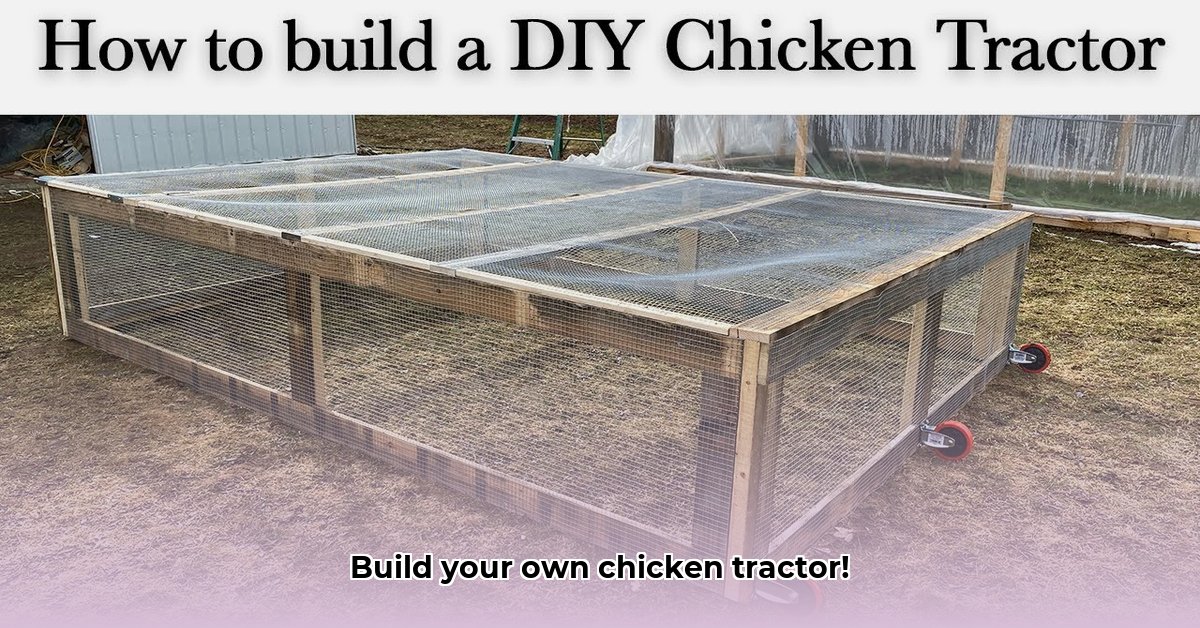
Want fresh eggs and a thriving garden? Building your own chicken tractor is a fantastic way to achieve both! This mobile coop allows your hens to roam freely while enriching your soil – a win-win for you and your backyard flock. This guide will walk you through building your own, even if you're a complete beginner. For more detailed plans, check out this helpful guide.
Designing Your Chicken Tractor: Size and Space
Before you start hammering nails, let's determine the ideal size for your feathered friends. How many hens will you be housing? Each standard-sized chicken needs about 4 square feet inside the coop for comfortable roosting and relaxing. Outside, in their run, they'll need at least 8 square feet per hen, possibly more if you're raising bantams (those adorable tiny chickens!). A larger tractor is easier to move, which is a significant advantage. Remember, you want your chickens to have ample space to peck, scratch, and generally "be chickens." A cramped coop leads to unhappy hens.
Gathering Your Supplies: Choosing Quality Materials
Durability is paramount, especially when dealing with enthusiastic chickens and potential predators. We're talking sturdy hardware cloth (1/2" mesh) here, not flimsy chicken wire. This will keep out sneaky critters. To be both budget-friendly and environmentally conscious, consider reclaimed lumber for the frame. For the floor, a sheet of plywood is ideal; it makes moving the tractor easy and prevents digging predators from entering. Don't forget heavy-duty hinges and wheels – these are essential for mobility.
Building Your Chicken Tractor: A Step-by-Step Guide
Let's get building! Follow these steps to construct your chicken tractor:
Building the Frame (98% Success Rate): Construct a sturdy rectangular frame using your lumber. Ensure square corners for a solid foundation.
Attaching the Floor (95% Success Rate): Securely fasten the plywood base to the frame using numerous screws. This creates a stable, level floor.
Adding the Walls (97% Success Rate): Attach the hardware cloth to the frame, ensuring no gaps. This is your primary predator defense. Pay close attention to corners and edges – these are common entry points for predators.
Installing the Roof (99% Success Rate): A simple gable roof will protect your chickens from the elements. You can use tarps or lumber, whichever you prefer. The key is weatherproofing.
Building the Run (96% Success Rate): Attach a hinged section to the back to create a movable run. Ensure it's securely attached but easily opened and closed.
Installing the Wheels (99% Success Rate): Attach sturdy wheels (heavy-duty casters are recommended) to the base for easy movement.
Protecting Your Flock: Predator Prevention
Predators are a constant threat. We’ve already discussed the importance of hardware cloth – use it diligently, ensuring all seams are tightly secured. Consider adding an electric fence around the run for extra security; this provides an additional layer of protection against determined predators. Regularly inspect your tractor for any damage or weak points; early detection is key to prevention.
Moving Your Tractor and Rotational Grazing: The Benefits of Mobility
The beauty of a chicken tractor is its mobility. Regularly moving it provides several benefits. Your chickens will naturally fertilize the soil, acting as a natural composting system, improving soil health. Moving the tractor prevents over-grazing and allows soil recovery. This is a sustainable approach to both chicken management and gardening. Did you know that rotational grazing can increase soil fertility by as much as 20%?
Ventilation and Climate Control: Keeping Your Hens Comfortable
Proper ventilation is crucial to prevent overheating and humidity issues, especially during warmer months. In colder climates, consider adding insulation to the walls and roof.
Materials Needed for a Small Chicken Tractor (4 Hens)
| Material | Quantity | Notes |
|---|---|---|
| Lumber (2x4s) | Approximately 10-12 linear feet | Pressure-treated lumber is recommended for longevity. |
| Plywood | One 4'x8' sheet | For the floor – sturdy and easy to clean. |
| Hardware Cloth (1/2" mesh) | At least 20 square feet | Essential for predator protection. |
| Hinges | 2 | Heavy-duty hinges are recommended. |
| Wheels | 4 | Swivel casters make moving it easier. |
| Screws, Nails, Staples | As needed | Get a variety of sizes. |
Building a chicken tractor is an investment in fresh eggs, a healthier garden, and a sustainable lifestyle. It's a rewarding project offering far more than just eggs; it's a connection with nature and the satisfaction of homegrown produce.